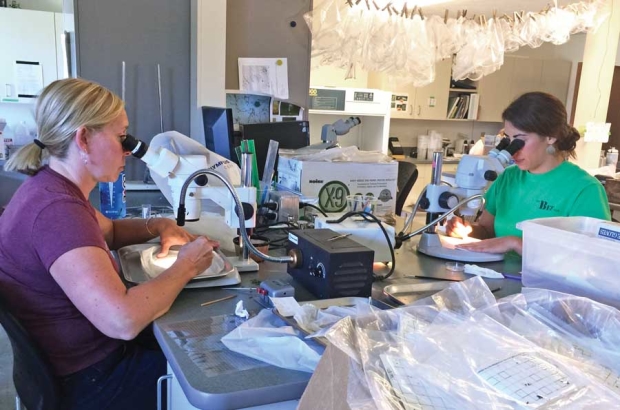
Nikki Rothwell, coordinator of the Northwest Michigan Horticulture Research Center, and fruit integrated pest management educator Emily Pochubay (right) use microscopes to scout for spotted wing drosophila larvae. (Courtesy Karen Powers)
Researchers hypothesized early last year that spotted wing drosophila populations wouldn’t reach high enough levels by mid-July to impact the tart cherry harvest in Michigan, but they did: Loads of fruit were rejected, dumped or juiced.
Could the same thing happen to Michigan sweet cherries in 2016?
That was the question posed by extension specialist Nikki Rothwell, coordinator of the Northwest Michigan Horticulture Research Center, during a talk at the December Great Lakes Fruit, Vegetable and Farm Market EXPO.
Rothwell explained that although SWD didn’t experience an exponential increase until August, populations did undergo an earlier-than-expected rise in July and therefore had an impact on tart cherries.
Her concern is that SWD numbers could reach a critical point even sooner and cause a similar problem for sweet cherries, which are harvested about 10 to 14 days earlier than tart cherries.
In addition, she noted research that has found sizable numbers of SWD larvae in wild-growing, noncrop hosts adjacent to commercial blocks of both tart and sweet cherries. (Read “Searching for spotted wing drosophila”)
This included Michigan studies showing heavy populations of SWD larvae in mulberry and honeysuckle in mid- to late-July, which coincides with late sweet cherry harvest.
Traps in those noncrop hosts, however, were catching no adults at that time, suggesting that adults had already migrated to other hosts, including cherries.
“These data, to me, indicate that we do have potential to have infestation in sweet cherries,” she said.
Rothwell said, “SWD adults are successfully reproducing in many noncrop hosts adjacent to sweet cherries, but (as of 2015) they were not building populations early enough to cause problems in commercial sweet cherry orchards.”
That said, she asserted that if mated females are reproducing successfully in noncrop hosts next to orchards just a bit earlier in the season, “it’s not a long flight to be moving into your commercial blocks.”
Rothwell and other extension agents will be keeping a close watch on SWD in 2016 to gain a better understanding of the fly’s population arc, its migration from noncrop hosts into cherries, and possible control measures, including the removal of host plants from the orchard’s periphery and the best timing for pesticides.
She said she hopes these efforts will provide needed guidance as growers in the state adjust to this intensifying pest. •
– by Leslie Mertz






Leave A Comment